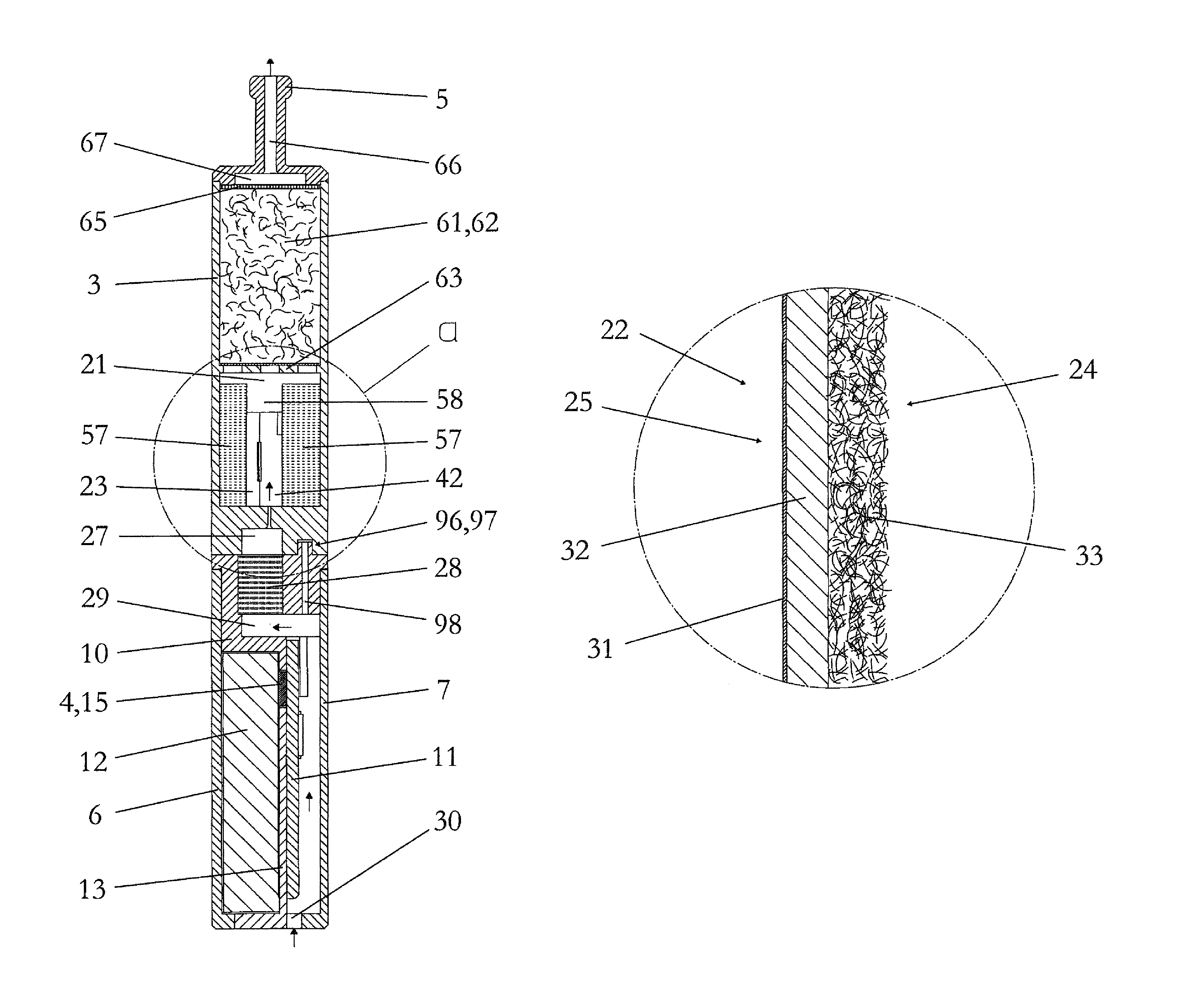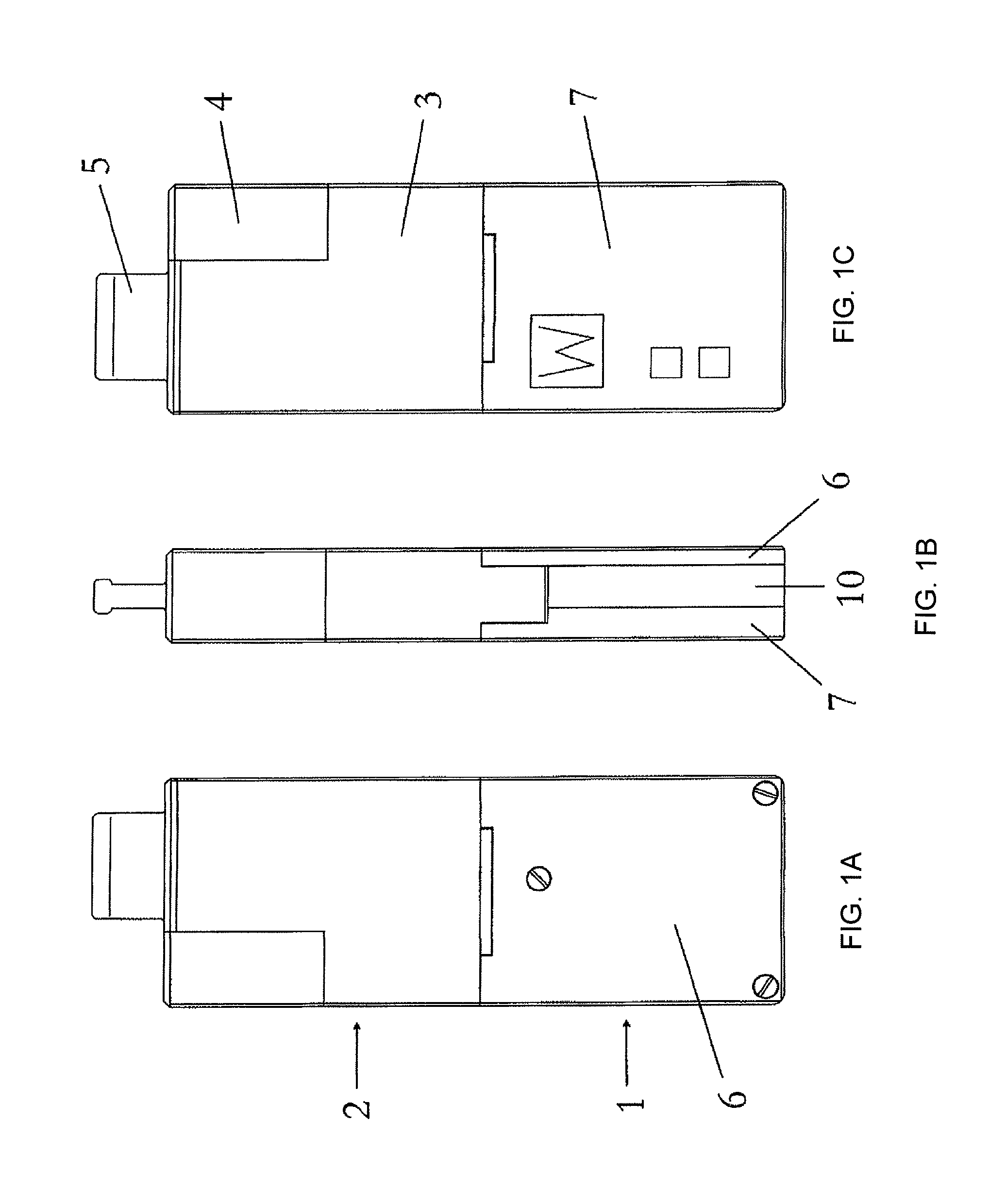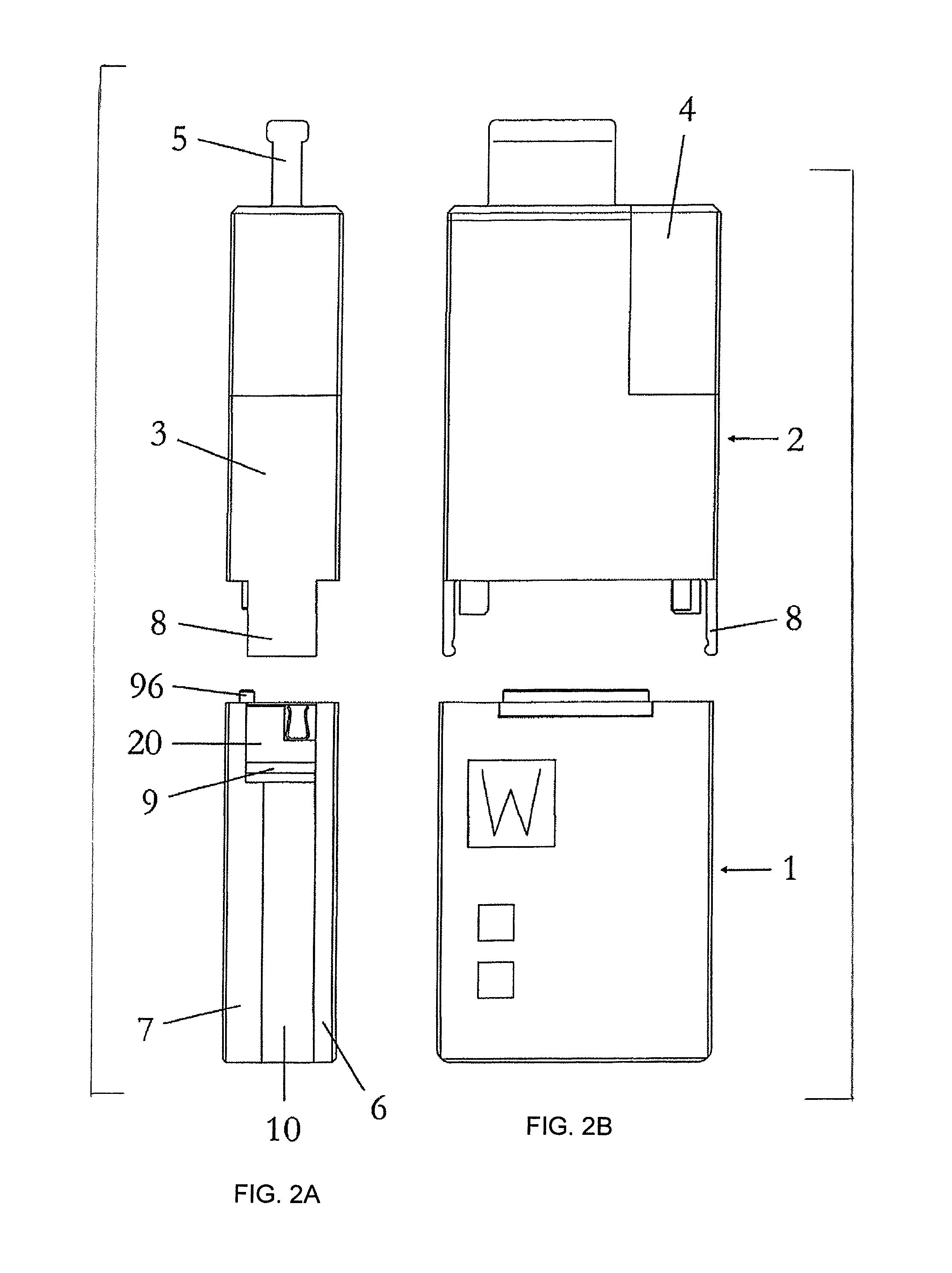The particular disadvantages of said arrangement include the complicated construction of the
evaporator, the mounting thereof and the connection of the wick to the
evaporator.
The multipart nature and complex structure of said construction makes the inhalator expensive to produce and makes
assembly complicated.
A serious
disadvantage is that the ratio of the vapor outlet surface to the
evaporator volume is relatively small.
As a result, even when the evaporative capacity in the evaporator is comparatively moderate, a boiling crisis may occur, and therefore said arrangement appears unsuitable for intermittent operation synchronous with
inhalation or drawing, said operation basically requiring a higher specific evaporative capacity with simultaneously high evaporator efficiency.
A further
disadvantage is that, despite the precautions which have been taken against the liquid medicament escaping from the supply container 30, such an escape cannot be entirely prevented by the construction, in particular if the supply container 30 is overfilled, for example due to erroneous operation.
A
disadvantage of this construction is the complicated process of producing the connection between the heating element and the wick.
Said procedure proves complicated in particular because the parts which are to be joined together are customarily of extremely small dimensions.
In addition, it is difficult to ensure that the heating wire coils all bear against the wick.
Local detachment may result in the heating wire overheating in these regions, and the resistance material can age more rapidly.
This problem also relates to the regions where the heating wire is connected to the electric conductors 1 and 2.
A further disadvantage involves the outer surface of the wick D being partially covered by the heating element 3 being coiled therearound.
In this respect, the coiling constitutes an obstacle to the vapor emerging from the wick.
Moreover, the vapor formed, as it flows out, comes at least partially into contact with the hot heating wire, which may result in
thermal decomposition of the medicament X.
Another disadvantage is that the wick D is held in position merely by the relatively thin heating wire 3.
The apparatus can be operated only in an upright or slightly inclined position; despite the structural measures taken, it is not possible to entirely prevent the medicament x from escaping from the vessel A. Finally, the medicament x in the vessel A is virtually freely exposed to the
ambient air; a fact which also has to be considered as being highly unfavorable.
The special structural conditions make the inhalation apparatus sluggish in terms of heating and the latter appears suitable at most for
continuous operation of the evaporator; intermittent operation synchronous with inhalation or drawing does not appear to be able to be realized.
The disadvantage again of said arrangements is the relatively complicated construction of the evaporator unit—in this case consisting of the capillary tube and the heating element.
Unfortunately, this document does not provide more precise instructions in this regard.
As a result, even at a moderate evaporative capacity, a boiling crisis may occur, and therefore the functioning of said arrangements should basically be doubted, particularly if intermittent operation synchronous with inhalation or drawing is required.
However, such a refilling involves risks for the environment, in particular if the liquid
aroma substance contains drugs or poisons, such as, for example,
nicotine, and the refilling is carried out by the user him / herself.
Small interchangeable containers always involve the risk of being swallowed by
small children, which may have a potentially lethal outcome, in particular if the liquid
aroma substance contains drugs or poisons, such as, for example,
nicotine.
A problem is that the inner surface is capable only to a limited extent of receiving condensate.
Also, drops are formed on the inner surface of the
mouthpiece under the influence of surface tensions, the drops steadily increasing in volume until the adhesion forces are ultimately no longer sufficient in order to hold the drops, and the latter combine to form relatively large accumulations of liquid.
Said accumulations of liquid may have an
adverse effect on the functioning of the apparatus but may also constitute a risk for the user and the environment if said accumulations contain
drug residues or poisons, such as, for example,
nicotine.
However, even the option of the user him / herself being able to remove the condensate from the apparatus involves a risk for the environment.
This also results in the following disadvantages: the
aerosol-forming substances or the
drug or / and any added
aroma substances which are released, for example, during the final drawing have already been repeatedly heated up beforehand, which circumstance prompts
thermal decomposition of the aerosol-forming substances.
In addition, said preceding heating operations are unfavorable in so far as additional
electric energy is required for this purpose, said energy not making any contribution to the actual
evaporation and aerosol formation.
This results in a very low evaporator efficiency.
A further disadvantage is that, in the case of mixtures of various aerosol-forming substances, drugs and aroma substances, with different boiling points of the individual substances, the
chemical composition of the aerosol formed and the
organoleptic and pharmacological effect thereof varies from one inhalation to the next, with low-boiling fractions increasingly being evaporated during the first drawings, and higher boiling substances increasingly being released during the final drawings.
Finally, the exchangeable unit 12 which is relatively complicated to produce, and therefore also the heating element 18, has to be replaced after just approximately 10 drawings, which makes the use of said articles expensive.
If it is furthermore taken into consideration that the complex, exchangeable unit 11 scarcely permits more than 15 drawings (cf. FIGS. 7A-7K), it is clear that the use of such an article would be expensive.
However, a disadvantage over the article according to U.S. Pat. No. 5,060,671 and U.S. Pat. No. 5,095,921 is that the support 36 has to be heated in addition to the heating elements 23; the heat required for this lowers the evaporator efficiency.
Some of the disadvantages of this metering unit have already been mentioned in U.S. Pat. No. 4,922,901.
Added thereto is the fact that the transfer of heat from the heating element to the pellet turns out to be highly unfavorable.
In principle, it is disadvantageous that, in order to form the pellet, use is made of solids which generally have to be melted first before they can be evaporated, thus causing a further deterioration in the
energy balance.
It is disadvantageous in both cases that, similarly as with a cigarette, the metering of the liquid to be atomized and of the aerosol formed depends on the particular drawing profile of the user.
However, this is undesirable for medicinal or therapeutic applications.
Said larger particle fractions do not pass into the pulmonary alveoli but rather are already absorbed in
lung sections located upstream, which, in the case of drugs acting systemically, such as nicotine, has a highly unfavorable effect on the absorption
kinetics and the efficiency of supply of the
active compound.
Furthermore, in particular in the case of the alternative variant embodiment without
ultrasound atomization, it has to be doubted whether the
electric heating element, which is designed in a manner similar to an incandescent
bulb wire, is even capable of transmitting the
heating energy required during drawing for the
evaporation to the liquid material.
Such high temperatures are basically associated with various risks and disadvantages—including with the risk of
thermal decomposition of the liquid to be atomized or already atomized.
Finally, it should be considered to be a high
safety risk that the container containing the highly poisonous solution of nicotine is open on an end side and furthermore can be detached from the “electric cigarette”.
This risk has already been identified, and in a development—as in DE 202006013439U—has been partially neutralized by the container being formed by a hermetically sealed
cartridge, but the
cartridge can disadvantageously still always be detached from the “electric cigarette” and can be swallowed, for example by
small children.
 Login to View More
Login to View More 


